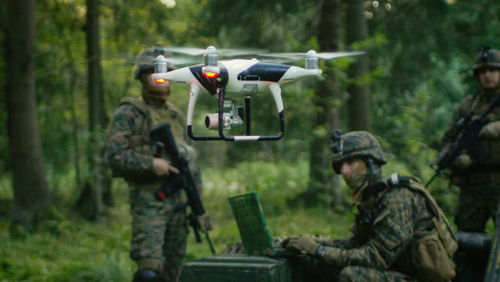Russia’s Yelabuga drone factory is churning out combat drones at a staggering pace, defying international scrutiny and setting a new standard in military manufacturing.
At a Glance
- Yelabuga drone factory in Russia is the largest of its kind, producing drones at nine times the planned rate.
- The factory uses Iranian drone designs, showcasing a deepened Russia-Iran military collaboration.
- Teenage apprentices are employed, reflecting a controversial labor strategy and social mobilization.
- The factory is a strategic target for Ukrainian long-range strikes, intensifying the conflict.
Russia’s Drone Manufacturing Surge
The Yelabuga drone factory, located in Tatarstan, Russia, has emerged as the world’s largest production facility for unmanned combat aerial vehicles. Initially intended as a special economic zone, it has been transformed into a powerhouse for military production, focusing on drones used against Ukraine. This development marks a significant escalation in Russia’s domestic drone manufacturing capabilities. The reliance on drones, especially the Geran series, mirrors the growing intensity of the war in Ukraine, with Moscow launching record numbers of drones at Ukrainian cities.
https://www.youtube.com/watch?v=vYoXukl_GIM
Russia’s ambition to achieve aerial superiority is evident in the factory’s rapid expansion, which has increased production ninefold. This surge in output indicates a strategic pivot, compensating for losses in conventional weaponry while maintaining pressure on Ukraine. The factory is over 1,000 kilometers from the Ukrainian border, making it a strategic asset and a potential target for Ukrainian strikes. The involvement of teenage apprentices highlights both the scale and social engineering aspects of Russia’s military-industrial mobilization.
Key Players and Geopolitical Dynamics
The Russian Ministry of Defence oversees the factory, with Zvezda, a ministry-owned TV channel, providing rare footage from inside the plant. Timur Shagivaleev, the plant director, sanctioned by the United States, claims the facility’s global primacy in drone production. Iran plays a crucial role by providing the original Shahed drone designs, facilitating Russia’s domestic production. The Ukrainian government and military, directly affected by the increased drone attacks, see the factory as a target for strikes to disrupt Russian operations.
The dynamics between Russia, Iran, and the West are complex. Russia and Iran have deepened their military and technological cooperation, with China also providing diplomatic and economic support. Western governments remain adversarial, seeking to limit Russia’s military capabilities through sanctions and diplomatic isolation. The Yelabuga factory symbolizes this geopolitical tug-of-war, with each party vying for strategic advantages.
Current Developments and Escalation
The factory is now fully operational, with production rates far exceeding initial projections. Hundreds of machines and thousands of workers, including many young apprentices, contribute to its output, which supports Russia’s drone barrages against Ukraine. This development marks a new phase in the conflict, as drones become central to modern warfare. The plant, featuring Soviet-era figures in its propaganda, aims to inspire a new generation of workers. However, its significance makes it a strategic target for Ukrainian long-range attacks.
Timur Shagivaleev’s public statements tout the factory’s scale and secrecy, while Russian state media broadcasts footage to show strength and deterrence. The timeline of events reflects Russia’s aggressive stance: from using Iranian-supplied Shahed drones in 2022 to establishing domestic production and achieving unprecedented output by mid-2025. The factory’s role in the conflict escalation cannot be overstated.
Implications and Global Reactions
The short-term implications of increased drone attacks on Ukrainian cities are dire, resulting in higher civilian casualties and infrastructure damage. This escalation fuels an arms race in drone technology and countermeasures between Russia and Ukraine. Long-term, drone warfare becomes entrenched in modern conflict, with Russia and Iran setting precedents for mass production and deployment. This trend could lead to similar developments in other conflict zones.
The economic and social impacts are profound. While the factory boosts the local economy in Tatarstan, it does so at the cost of militarization and potential targeting. The mobilization of youth into military production normalizes such activities in civilian life, raising ethical and societal concerns. Politically, the deepening rift between Russia/Iran and the West leads to increased sanctions and international isolation, with the drone industry facing accelerated innovation and implications for global security.

